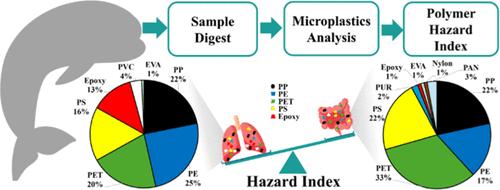江豚肺组织与肠道内容物微塑料的比较
IF 11.3
1区 环境科学与生态学
Q1 ENGINEERING, ENVIRONMENTAL
引用次数: 0
摘要
微塑料是陆地、海洋和大气生态系统中普遍存在的环境污染物。塑料通过风化或磨损进入大气,将微塑料分散到全球,通过吸入进入动物的呼吸系统。我们首次分析了11只死江豚(Neophocaena asiaeorientalis)的肺组织和肠道内容物,以评估其从猎物和大气来源摄入微塑料的情况。肺组织和肠道内容物的平均浓度分别为0.14±0.11 MPs/g和0.35±0.36 MPs/g。在肺组织和肠道内容物中发现的微塑料在物理特征上相似(例如,碎片形状,透明到白色,大小为100 μm)。另一方面,它们在聚合物类型上有所不同,肺部中环氧型微塑料的比例更高。根据聚合物危害指数,环氧树脂属于高危害聚合物,在本研究中,肺组织的塑料危害指数高于肠道内容物。因此,呼吸系统比消化系统更容易受到来自大气的微塑料污染的影响。这些发现强调了空气中的微塑料对包括海洋哺乳动物在内的肺呼吸动物的威胁越来越大。本文章由计算机程序翻译,如有差异,请以英文原文为准。

Comparison of Microplastics between Lung Tissues and Intestinal Contents in Finless Porpoises (Neophocaena asiaeorientalis)
Microplastics are ubiquitous environmental pollutants in terrestrial, marine, and atmospheric ecosystems. Plastic inputs into the atmosphere occur through weathering or abrasion, dispersing microplastics globally, which can enter the animals’ respiratory systems through inhalation. We analyzed the lung tissues for the first time and the intestinal contents of 11 dead finless porpoises (Neophocaena asiaeorientalis) to assess the intake of microplastics from prey and atmospheric sources. The lung tissues and intestinal contents contained average concentrations of 0.14 ± 0.11 MPs/g and 0.35 ± 0.36 MPs/g, respectively. Microplastics found in the lung tissues and intestinal contents were similar in physical characteristics (e.g., fragment shape, transparent to white color, and size <100 μm). On the other hand, they differed in the polymer types, with a higher proportion of epoxy-type microplastics in the lungs. Epoxy is a highly hazardous polymer according to the polymer hazard index, and in the present study, the lung tissues had a higher plastic hazard index than the intestinal contents. Hence, the respiratory system is more vulnerable to microplastic pollution from atmospheric sources than the digestive system is from water and food intake. These findings underscore the growing threat of airborne microplastics to lung-breathing animals including marine mammals.
求助全文
通过发布文献求助,成功后即可免费获取论文全文。
去求助
来源期刊

环境科学与技术
环境科学-工程:环境
CiteScore
17.50
自引率
9.60%
发文量
12359
审稿时长
2.8 months
期刊介绍:
Environmental Science & Technology (ES&T) is a co-sponsored academic and technical magazine by the Hubei Provincial Environmental Protection Bureau and the Hubei Provincial Academy of Environmental Sciences.
Environmental Science & Technology (ES&T) holds the status of Chinese core journals, scientific papers source journals of China, Chinese Science Citation Database source journals, and Chinese Academic Journal Comprehensive Evaluation Database source journals. This publication focuses on the academic field of environmental protection, featuring articles related to environmental protection and technical advancements.
 求助内容:
求助内容: 应助结果提醒方式:
应助结果提醒方式:


